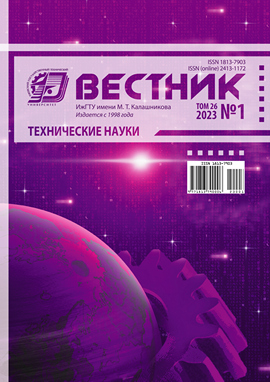Оценка качества передачи мультипотоковых видеоданных с борта беспилотного летательного аппарата к наземной станции в имитационной среде Network Simulator 3 с использованием стандартов Wi-Fi
DOI:
https://doi.org/10.22213/2413-1172-2023-1-91-99Ключевые слова:
мультипотоковая передача, бплаАннотация
Представлены результаты имитационного моделирования процесса передачи видеоданных в режиме реального времени с видеокамер на борту беспилотных летательных аппаратов к наземной станции. Основной целью статьи является оценка влияния количества летающих узлов-источников на метрики Qualityof Service (QoS), такие как коэффициент доставки пакетов (Packet Delivery Ratio) и полезная пропускная способность (Goodput) на прикладном уровне модели Open Systems Interconnection (OSI). Рассмотрен сценарий, в котором зависшие в воздухе беспилотные летательные аппараты в зоне устойчивой связи передавали поток видеоданных на наземную станцию. Далее расстояние между беспилотными летательными аппаратами и наземной станцией увеличивалось для повторной итерации эксперимента. В ходе эксперимента скорость передачи данных поддерживалась на одном уровне, близком к скорости передачи реального видео высокого разрешения. Эксперимент проводился в среде имитационного моделирования Network Simulator 3 (NS-3). В эксперименте рассматривались сценарии с разным количеством узлов-источников: одним, двумя, четырьмя и восемью. По результатам моделирования было выявлено негативное влияние увеличения количества летающих узлов-источников на показатели качества обслуживания (QoS), таких как коэффициент доставки пакетов (PDR) и Goodput. Даны рекомендации по улучшению качества связи для сценариев использования беспилотных летательных аппаратов в режиме мультипотоковой передачи видеоданных, такие как добавление узлов-ретрансляторов для балансировки нагрузки и использование ARQ прикладного уровня. Также было обнаружено изменение зависимости полезной пропускной способности на 15 % от количества узлов-источников.Библиографические ссылки
Saliba D. (2019) Planning and Profit Sharing in Overlay WiFi and LTE Systems toward 5G Networks. J. of Software Engineering and Applications, 2019, vol. 12, pp. 491-508.
Chen Y. C., Towsley D., Khalili R. (2016) MSPlayer: Multi-source and multi-path video streaming. IEEE J. on Selected Areas in Communications, 2016, vol. 34, no. 8, pp. 2198-2206.
Shvyrev B. A., Timonov D. A. (2019) Acoustic information leakage channel by means of visible light modulation // Вестник УрФО. 2019. Т. 31, № 1. С. 11-16.
Глушаков В. Е. Исследование различных моделей передачи данных двумя станциями в сети Wi-Fi // Международный научно-исследовательский журнал. 2021. № 9-1 (111). С. 17-24.
Masiukiewicz A. (2019) Throughput comparison between the new HEW 802.11 ax standard and 802.11 n/ac standards in selected distance windows.International J. of Electronics and Telecommunications, 2019,vol. 65, no. 1, pp. 79-84.
Khan G. Z. (2016) On the Field Level Loss of a VHT PPDU in a MIMO-OFDM System for a WiFi Direct 802.11 ac WLAN.2016 International Conference on Frontiers of Information Technology (FIT). IEEE, 2016, pp. 164-169.
Karmakar R., Chattopadhyay S., Chakraborty S. (2017) Impact of IEEE 802.11 n/ac PHY/MAC high throughput enhancements on transport and application protocols. IEEE Communications Surveys & Tutorials, 2017, vol. 19, no. 4, pp. 2050-2091.
Sun X. (2019) Physical layer security in UAV systems: Challenges and opportunities. IEEE Wireless Communications, 2019, vol. 26, no. 5, pp. 40-47.
Li B. (2019) Physical-layer security in space information networks. IEEE Internet of Things J., 2019, vol. 7, no. 1, pp. 33-52.
Фокин Г. А., Владыко А. Г. Позиционирование транспортных средств с комплексированием дальномерных, угломерных и инерциальных измерений в расширенном фильтре Калмана // Труды учебных заведений связи. 2021. № 7 (2). С. 51-67.
Borges D. (2019) Low Complexity Millimeter Wave Point-to-point Communication: Interference Assessment of BPSK vs QPSK Decomposition. 2019 PhotonIcs & Electromagnetics Research Symposium-Spring (PIERS-Spring). IEEE, 2019, pp. 2376-2384.
Sharoar Jahan Choyon A. K. M., Chowdhury R. (2020) Performance comparison of free-space optical (FSO) communication link under OOK, BPSK, DPSK, QPSK and 8-PSK modulation formats in the presence of strong atmospheric turbulence. J. of Optical Communications, 2020.
Репин Д. С., Филаретов Г. Ф., Червова А. А. Исследование фрактальных характеристик сетевого трафика // Информатизация образования и науки. 2019. № 2. С. 48-67.
Кутузов О. И., Татарникова Т. М. Метод ускоренного имитационного моделирования сетевых узлов коммутации // Известия высших учебных заведений. Приборостроение. 2019. Т. 62, № 1. С. 23-31.
Rochim A. F. (2020) Performance Comparison of Wireless Protocol IEEE 802.11 ax vs 802.11 ac. 2020 International Conference on Smart Technology and Applications (ICoSTA). IEEE, 2020, pp. 1-5.
Ravindranath N. S. (2016) Performance Evaluation of IEEE 802.11 ac and 802.11 n using NS3. Indian J. of Science and Technology, 2016, vol. 9, no. 26, pp. 1-9.
Masiukiewicz A. (2019) Throughput comparis on between the new HEW 802.11 ax standard and 802.11 n/ac standards in selected distance windows.International J. of Electronics and Telecommunications, 2019, vol. 65, no. 1, pp. 79-84.
Обзор методов улучшения доставки потоковых данных в беспроводных самоорганизующихся сетях / В. В. Титов [и др.] // Приборостроение в XXI веке - 2020. Интеграция науки, образования и производства: материалы конференции. Изд-во УИР ИжГТУ имени М. Т. Калашникова, 2020. С. 226-233.
Campanile L. (2020) Computer network simulation with ns-3: A systematic literature review. Electronics, 2020, vol. 9, no. 2, p. 272.
Кайсина И. А. Моделирование полезной пропускной способности сети БПЛА при мультипотоковой передаче // Труды учебных заведений связи. 2020. Т. 6, № 1. С. 100-108.
Загрузки
Опубликован
Как цитировать
Выпуск
Раздел
Лицензия
Copyright (c) 2023 Вестник ИжГТУ имени М.Т. Калашникова

Это произведение доступно по лицензии Creative Commons «Attribution» («Атрибуция») 4.0 Всемирная.


